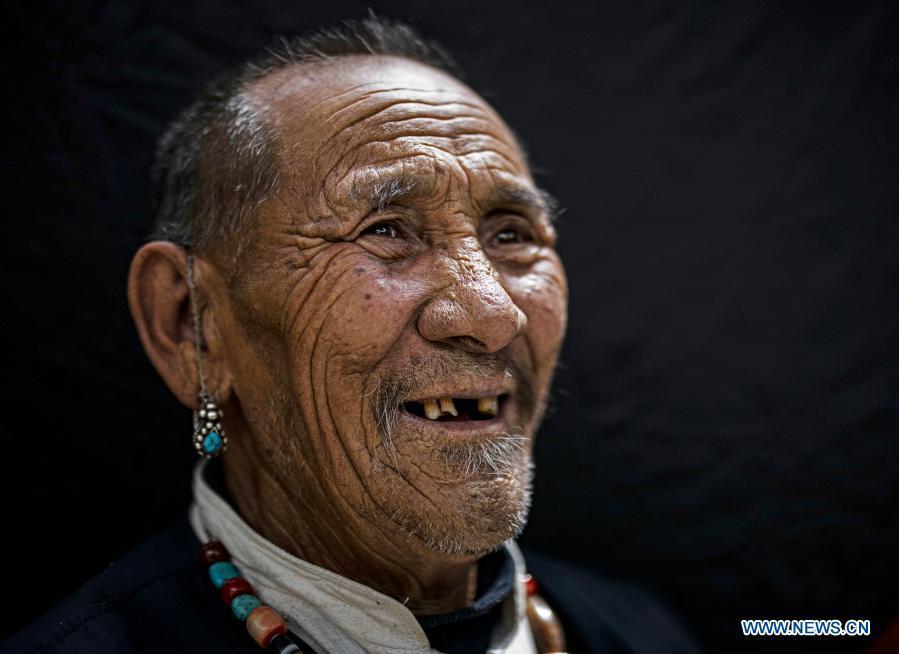Source:Xinhua 2021年05月31日 16:46

Cedain does exercises at the care center in Ngari Prefecture, southwest China's Tibet Autonomous Region, March 19, 2021. Cedain, born in 1941, is a villager of Qianjin Village of Gar County, Ngari Prefecture, Tibet Autonomous Region. Without farmland and enough food, the former serf and his family lived on begging in the old times. Such a plight came to an end in 1959, after a democratic reform liberated more than 1 million people, or 90 percent of the population of the region at that time, from the feudal serfdom. Cedain's family was granted farmland to grow crops and began to feed livestock, living on a normal life with their own efforts. Now Cedain enjoys the comfort in his old age at the care center in Ngari Prefecture. (Photo by Konchog Chosphel/Xinhua)

Photo taken on March 19, 2021 shows a portrait of Cedain in Ngari Prefecture, southwest China's Tibet Autonomous Region. Cedain, born in 1941, is a villager of Qianjin Village of Gar County, Ngari Prefecture, Tibet Autonomous Region. Without farmland and enough food, the former serf and his family lived on begging in the old times. Such a plight came to an end in 1959, after a democratic reform liberated more than 1 million people, or 90 percent of the population of the region at that time, from the feudal serfdom. Cedain's family was granted farmland to grow crops and began to feed livestock, living on a normal life with their own efforts. Now Cedain enjoys the comfort in his old age at the care center in Ngari Prefecture. (Photo by Konchog Chosphel/Xinhua)

Cedain (1st R) plays games with his friends at the care center in Ngari Prefecture, southwest China's Tibet Autonomous Region, March 19, 2021. Cedain, born in 1941, is a villager of Qianjin Village of Gar County, Ngari Prefecture, Tibet Autonomous Region. Without farmland and enough food, the former serf and his family lived on begging in the old times. Such a plight came to an end in 1959, after a democratic reform liberated more than 1 million people, or 90 percent of the population of the region at that time, from the feudal serfdom. Cedain's family was granted farmland to grow crops and began to feed livestock, living on a normal life with their own efforts. Now Cedain enjoys the comfort in his old age at the care center in Ngari Prefecture. (Photo by Konchog Chosphel/Xinhua)

Cedain receives massage treatment at the care center in Ngari Prefecture, southwest China's Tibet Autonomous Region, March 19, 2021. Cedain, born in 1941, is a villager of Qianjin Village of Gar County, Ngari Prefecture, Tibet Autonomous Region. Without farmland and enough food, the former serf and his family lived on begging in the old times. Such a plight came to an end in 1959, after a democratic reform liberated more than 1 million people, or 90 percent of the population of the region at that time, from the feudal serfdom. Cedain's family was granted farmland to grow crops and began to feed livestock, living on a normal life with their own efforts. Now Cedain enjoys the comfort in his old age at the care center in Ngari Prefecture. (Photo by Konchog Chosphel/Xinhua)

Cedain (1st R) poses for a group photo with his friends at the care center in Ngari Prefecture, southwest China's Tibet Autonomous Region, March 19, 2021. Cedain, born in 1941, is a villager of Qianjin Village of Gar County, Ngari Prefecture, Tibet Autonomous Region. Without farmland and enough food, the former serf and his family lived on begging in the old times. Such a plight came to an end in 1959, after a democratic reform liberated more than 1 million people, or 90 percent of the population of the region at that time, from the feudal serfdom. Cedain's family was granted farmland to grow crops and began to feed livestock, living on a normal life with their own efforts. Now Cedain enjoys the comfort in his old age at the care center in Ngari Prefecture. (Photo by Konchog Chosphel/Xinhua)